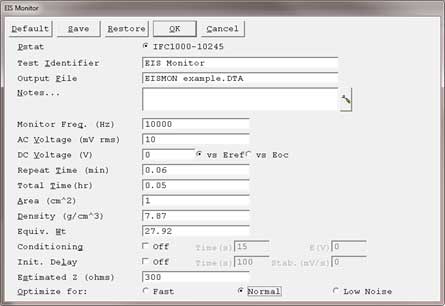Single Frequency EIS
Introduction
Single Frequency EIS is a technique in Gamry’s EIS application package. It is used to follow changes in electrochemical impedance versus time. The most common use is in impedance-based sensor development and in on-line sensor systems. It can also be used to follow degradation of batteries or coating systems. Unlike standard EIS, it does not provide a spectrum. Instead, Single Frequency EIS periodically measures electrochemical impedance at one frequency. The measurement is made with a constant DC potential applied to the cell.
Run Single Frequency EIS by choosing Experiment > Electrochemical Impedance > Single Frequency EIS.
Setup
Most of the experimental Setup screen will look familiar to an EIS user. A sample Setup can be seen below:

The Monitor Freq. parameter is the single AC frequency to be applied to the cell.
AC Voltage is the amplitude of the AC signal.
DC Voltage is the DC bias voltage applied to the cell.
Repeat Time is the number of minutes between measurements. The Repeat Time must be longer than the time needed for the measurement. Gamry’s EIS measurements require at least 2 cycles at the frequency of interest and typically requires five or more cycles. As a guideline, allow at least 3 seconds for measurement of a single impedance value with a frequency above 100 Hz. If you enter a Repeat Time of less than one second and the measurement takes less than one second, the impedance is reported at one-second intervals.
The Optimize for setting also has a major influence on the time required for a measurement. With the Low Noise radio button selected, a 10 kHz measurement cannot be completed in one second. With the Fast radio button selected, it can.
The data file from a Single Frequency EIS test can be plotted and analyzed using our Echem Analyst™. The x-axis of the plot is time. A variety of quantities can be plotted on the y-axis.

Comments are closed.